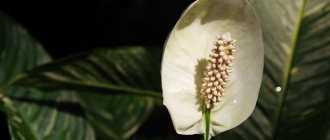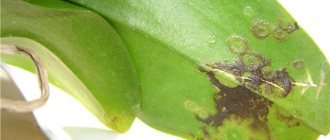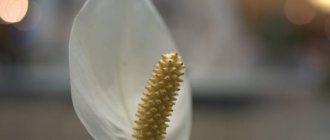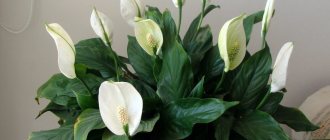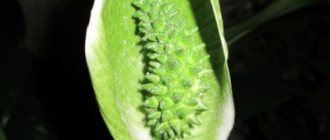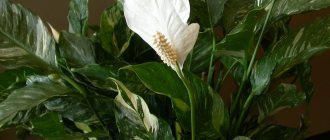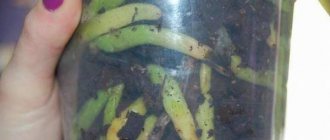Spathiphyllum is a native of the tropical areas of South and Central America and East Asia, a representative of the huge Aronnikov family. A lush, spreading bush with bright, rich greenery and huge snow-white sail flowers are characteristic features of this homemade exotic.
The evergreen rhizomatous perennial is not at all pretentious or capricious in everyday life, despite its majestic and pompous appearance. And yet spathiphyllum can hurt. The main root cause of any ailment is care errors, violation of the watering regime, lack of heat and light, or, conversely, excess nutrition and moisture.
A damp, poor, dense substrate, sudden changes in temperature, a cold window sill or darkened “habitats” - the heat-loving spathiphyllum loses its immunity, becomes vulnerable and susceptible to diseases. A pathogenic environment provokes the appearance of pests - carriers of fungal or bacterial infections.
What most often affects the plant?
- Lack of growth - excessive soil moisture or excess sun rays.
- Brown spots on the foliage are a sign of pest damage or excessive moisture. Lack or abundance of moisture leads to the appearance of black tips.
- Blackness on the surface of the leaf blade means a low content of nitrogen, phosphorus, and potassium.
- Dry tips on a young plant indicate that it is adapting to new conditions.
- If a formed bush suffers , change watering, making it frequent.
- Lack of flowering - transplantation into an overly large pot occurred, which led to the growth of the root system, instead of throwing out flower stalks.
If the transplant was not carried out, and there are still no buds, you need to place the pot on the balcony for 2 weeks and maintain the temperature at least 12-13 degrees. - Curling leaves are a sign of a cold room. The optimal temperature for this family is +18…+24 degrees.
- Loss of flower brightness and wilting is often associated with root rot.
Is it possible to keep a “female happiness” flower at home?
Apart from superstitions that should not be taken seriously, exotics can be dangerous for children or pets. Oxalate crystals are present in its tissues. If they get into the mouth, irritation or even swelling of the mucous membranes may occur. You need to know about this and place the plant in the house so that everyone who it could harm does not get to it.
Normal growth and development of culture is possible only in favorable conditions. Let’s list what kind of care the indoor flower “female happiness” needs (it’s in the photo below).
When and what should be treated, how to do it?
Urgent resuscitation is done when previous efforts have not produced a positive effect and the pet’s condition is worsening every day.
Black leaves, delayed flowering, a dark-colored root system, withered crown of young shoots, stunted growth - these are clear signs of a dying bush. How to cure a plant?
The rescue goes like this::
- The spathiphyllum is removed from the pot and the rotten roots are cut off.
- Intact roots are washed with potassium permanganate. After this, they are treated with activated carbon and wrapped in newspaper for a day.
- While they are drying, a container with new soil is prepared. The soil is poured into the pot after drainage holes are made and a drainage layer is laid.
- Next, the flower is transplanted into new soil.
- Immediately after transplantation, watering is not performed. The top of the spathiphyllum is covered with plastic film or a plastic bottle, creating a greenhouse effect.
Why does spathiphyllum wither?
Why do spathiphyllum leaves wither? It seems that the reason is simple - the plant has not been watered for a long time and the soil in its pot is completely dry. This is partly true, but there are also several other reasons:
- The soil is based on peat, the flower is watered regularly, but its wilting is still observed. In this case, the plant is not only watered from above, but it also needs to be lowered into a basin of water for 10-20 minutes so that the ground and below are saturated with moisture.
- If the soil is dense and non-hygroscopic, then it is wet only on top, and in the depths of the pot it is overdried. The plant is urgently required to be replanted in a light, homogeneous soil mixture.
- Spathiphyllum is overly flooded with water and the flower fades due to decay.
How can you tell if a flower's roots are rotting? It has not been watered for a long time, but there is still moisture on the surface. Spathiphyllum is sick, so its roots do not absorb water.
This disease is difficult for a novice gardener to diagnose. The following situation occurs: the spathiphyllum withers, home care is enhanced with even more water, but this is precisely what cannot be done. What to do if the roots of spathiphyllum rot?
Spathiphyllum requires replanting with obligatory pruning of rotten root tips:
- Carefully remove it from the pot, making sure that the leaves and roots are not damaged further.
- We thoroughly wash the roots, but not in running water, but, for example, in a bucket or basin.
- When the roots are freed from the ground, it is clearly visible which of them are damaged and to which places they need to be cut. Cut with a sharp garden knife.
- Be sure to sprinkle all the cuts with crushed activated carbon.
- In this state, the plant is left alone for several hours to dry completely.
- We plant the flower in new light soil, to which we also add activated carbon, which will prevent rotting in the future.
- You can't water it right away. The first watering occurs after 1-2 days; a special root formation stimulator must be added to the water. Kornevin deserves good reviews.
How to prevent the problem from happening again?
- Carry out regular inspection of the flower.
- Fertilize with Fitoverm.
- Do not use a sprayer with large openings.
- Maintain optimal room temperature.
- Spray with water in winter and autumn to combat dry air masses.
- Water as the soil dries out.
- Feed with complex fertilizers once every 30-45 days.
Spathiphyllum does not often suffer from illnesses . His illnesses in most cases are the result of improper care. If you notice the blackening of the leaves in time and identify the cause of this condition, the plant can be saved.
What pests affect us and how to fight them?
Insects appear in contaminated soil ( it is necessary to calcinate and treat the substrate when planting ) and due to improper care (dampness or dryness, dust, high air humidity).
Mealybug
- The affected area is the leaf axils. A favorable environment for the pest is heat, dryness, and stagnant air in the room.
- Rescue measures - treatment through spraying with Karbofos, Fozalon.
Important! Preventive measures are required - re-spraying after 7-10 days.
Aphid
A small sucking pest that spreads. Leaves sticky discharge of an infectious nature . It deforms flowers and devours everything in its path. At first, the juice is sucked out, the leaves and stems lose color, and the buds do not open as a result of the damage.
Thorough treatment with systemic agents (Aktara, Konfidor) or insecticides (Fitoverm, BI-58, Fufafon, Karate) will help.
Shchitovka
A dangerous insect with a waxy shell that spreads on the stems of flower stalks, leaves and petioles. It sucks out the juices and the plant gradually dies . It is important to collect it mechanically with a soft brush. And then spray the bushes with an insecticide (Asparagus, Adiantum, Intavir, Aktara).
Spider mite
Also a sucking pest. The consequences are disastrous for spathiphyllum - the leaves become entwined with cobwebs, turn pale and die.
A quick way to get rid of the pest is to treat it with a soap solution (in the initial stages). In advanced cases, Fitoverm will help. The treatment is repeated every 5-6 days.
Thrips
Small insects leave whitish marks. Signs of damage by these bugs - on the outer and inner surface of the leaf plate of the “female happiness” flower, white, dry stripes are visible, then the leaves turn black and fall off. Spraying with Confidor will help.
Interesting fact . Potassium increases the immunity of house plants and compacts cells. Pathogens and pests do not penetrate the tissue structure. The simplest potassium-containing product is potato broth.
Kinds
Of the more than forty species of spathiphyllum, there are more or less in demand by amateur gardeners. We offer you several popular species, among which you are sure to find a plant that suits you.
Spathiphyllum wallisii
Compact bush 15-30 cm in height from Colombian rain forests, leaves are graceful, oblong-lanceolate. The cob is white, as is the spathe, which is three times longer than the cob. Over time, the blanket begins to turn green. Blooms profusely and for a long time.
In the photo: Spathiphyllum wallisii
Spathiphyllum Domino
A variety bred on the basis of Spathiphyllum Wallis, differing from its derivative only in the variegated white-green color of the leaves. Very popular.
Spathiphyllum Sensation
A very large Dutch variety, growing up to one and a half meters in height. Dark green ribbed leaf plates reach 70-90 cm in length and 30-40 cm in width. It is widely used to decorate large, dimly lit rooms.
In the photo: Spathiphyllum Domino (Spathiphyllum Domino)
Spathiphyllum floribundum
Also native to Colombia, reaches half a meter in height, oval-lanceolate, densely growing leaves up to 25 cm long and 9-12 cm wide, the surface is dark and velvety, the lower part of the leaf blade is noticeably lighter than the upper. The bedspread is white. It blooms for a very long time and abundantly.
Spathiphyllum floribundum Mauna Loa
A hybrid bred in the USA based on Spathiphyllum profusely flowering. The leaves reach a length of 70 cm, the peduncle is long, so the plant can be grown as a cut flower. The bedspread is snow-white, wide oval. The lower leaves droop over time, and the plant becomes like a cascading bush.
In the photo: Spathiphyllum floribundum Mauna Loa
Spathiphyllum heliconiifolium
It grows naturally in Brazil. Reaches a meter in height. Leaves are up to half a meter long and 20-25 cm wide, pointed, glossy, wavy at the edges, dark green in color. The spadix, 8-10 cm long, is wrapped in a white spathe, which is twice as long as the inflorescence. The blanket gradually turns green and then turns black.
Among the cultivated species, Spathiphyllum spoon-shaped, Spathiphyllum cannofolia, Spathiphyllum charming and others are also popular.
Growing conditions
Spathiphyllum does not have a stem, so the basal leaves grow in a bunch directly from a short rhizome, reaching a height of 15 cm to 1 m, depending on the type and variety. Spathiphyllum leaves are whole, lanceolate or oval, the veins are prominently expressed. The inflorescence looks like a spadix on a long stalk, wrapped in a blanket similar in shape to a spathiphyllum leaf, only white, although over time the blanket gradually turns green. Spathiphyllum blooms for several weeks, usually in spring, but it happens that with good care the plant blooms twice a year. The evergreen beauty of spathiphyllum leaves, the graceful shape of the inflorescence, as well as the undemanding conditions of its maintenance have made spathiphyllum so popular among lovers of indoor plants.
- Photos of Dieffenbachia species with names
Despite the fact that in nature spathiphyllum grows in the lower tier of tropical forests and is a shade-tolerant plant, it is best to keep it under bright, diffused light, for example, in an eastern window. If the lighting is insufficient, the flowering period of the spathiphyllum will be shortened, and it may happen that the spathiphyllum will not bloom at all. As for the air temperature, the extreme limits for keeping the plant in both winter and summer are 15-32 ºC. Drafts and a cold winter window sill are dangerous for it - so that the plant does not suffer from the cold, place a circle of foam under the flowerpot with a flower.
Mealybug
Mealybug loves moisture, so it only attacks those spathiphyllums that are constantly overwatered. Pests hide between the leaves.
You can wipe the leaves with a cloth soaked in alcohol and mechanically remove all pests. I like the method of drying the soil a little (do not water) and placing half of the cut potatoes on the ground.
Pests love dampness very much, so they will run under it like a fungus, then throw it away. If all else fails, you will have to treat with the drug.
